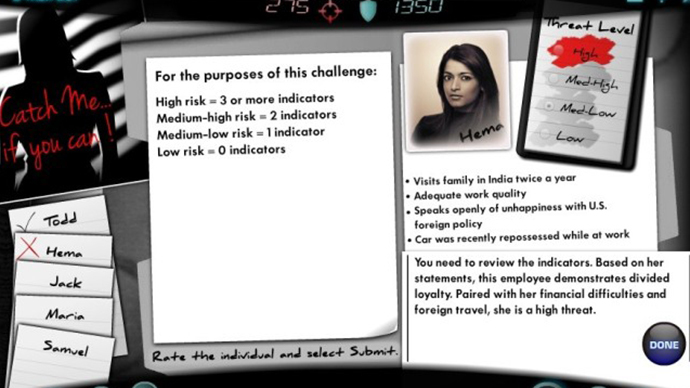Pentagon considers employees unhappy with US policies a security threat

The Pentagon is warning its employees to be on the look-out for colleagues who demonstrate an “unhappiness with US foreign policy,” visit family abroad and have financial problems – traits that classify someone as an “insider threat”.
Afraid that its federal employees could follow the footsteps of Army Private first class Bradley Manning, the Defense Department is taking long strides to find potential information leakers. As part of its “Insider Threat” program, which requires government workers to monitor and spy on each other, the Defense Information Systems Agency (DISA) has required staffers to sit through an online presentation that outlines traits qualifying someone as a “high threat”.
DISA defines insider risks as “threats from people who have
access to the organization’s information systems and may cause
loss of physical inventory, data, and other security
risks,” the Huffington Post reports.

To help federal employees identify “high risk” individuals, the DISA created a “CyberAwareness Challenge”, which was posted in Oct. 2012 – one month before the Insider Threat policy was completed. One section of the security challenge requires employees to identify the threat levels of hypothetical individuals that they may encounter in their offices.
An example of a “high threat” individual is an Indian woman named Hema, who travels to India twice a year to visit family and who “speaks openly of unhappiness with US foreign policy.” This woman demonstrates an “adequate work quality” and had her car repossessed while at work.
“Based on her statements, this employee demonstrates divided
loyalty,” the program explains. “Paired with her financial
difficulties and foreign travel, she is a high threat.”

The training program encourages Pentagon staffers to “catch me if you can”, referring to individuals whose traits deem them more likely to leak sensitive information or put the country at risk.
Pentagon spokesman Lt. Col. Damien Pickart defended the program to the Huffington Post, arguing that it is valid “based on past examples of personnel who engaged in spying or treasonous acts.”
But Steven Aftergood, an expert on government secrecy at the Federation of American Scientists, said the training was “ignorant and clumsy”, since it scrutinizes individuals simply for expressing their right to free speech about US foreign policy, which not everyone agrees with completely.

"The item 'speaks openly of unhappiness with U.S. foreign policy' simply does not belong on the list," Aftergood said. "It is not a threat indicator. It could apply to most members of Congress, if not to most Americans. By presenting the matter this way, the slide suggests that overt dissent is a security concern. That is an error."
The Insider Threat program was first authorized in Oct. 2011, after Pfc. Bradley Manning sent classified information to the anti-secrecy website WikiLeaks. Manning is currently facing a maximum prison sentence of 90 years for releasing hundreds of thousands of documents, including field reports and logs from the Afghan and Iraq wars.
In an attempt to prevent information leaks, the DISA’s Insider Threat program urges government workers to spy on each other, facing hefty penalties if they fail to alert their superiors of a potential security breach. Threat indicators include stress, relationship issues, financial problems, odd work hours and random traveling. And an Indian woman like Hema, who visits her family twice a year, couldn’t make her car payments, and disagrees with the Obama administration’s foreign policy, is considered an example of a “high threat” individual that the Pentagon considers a danger to the United States.















